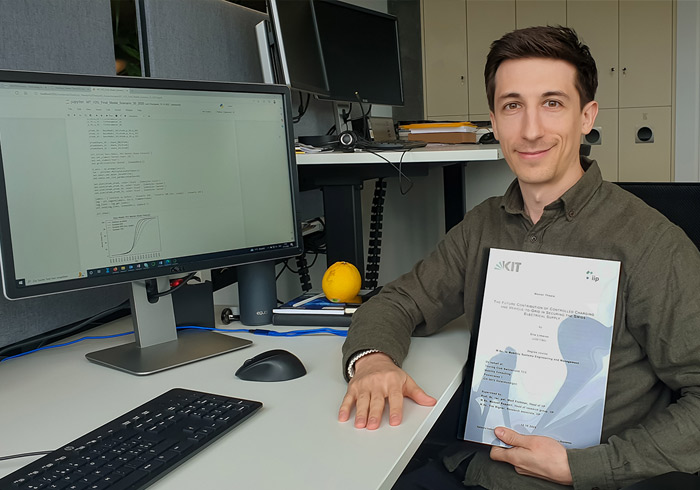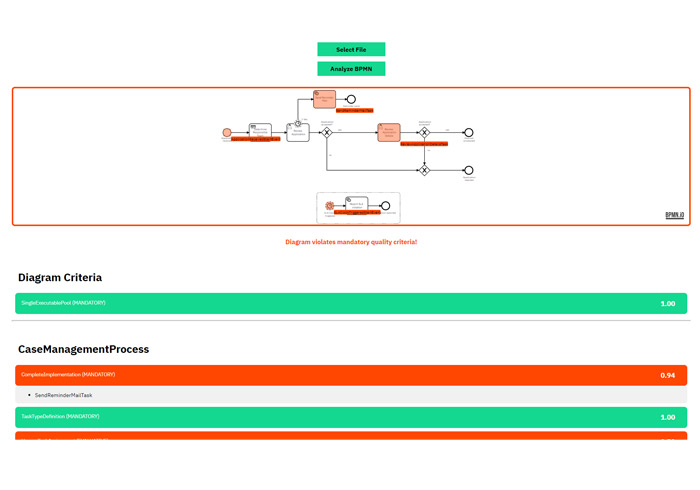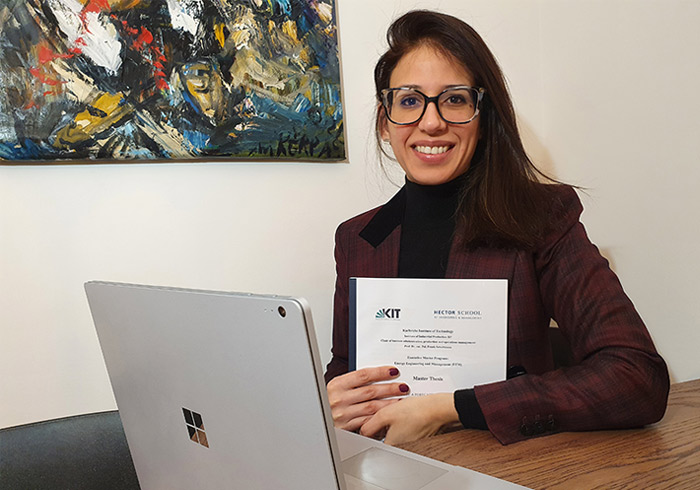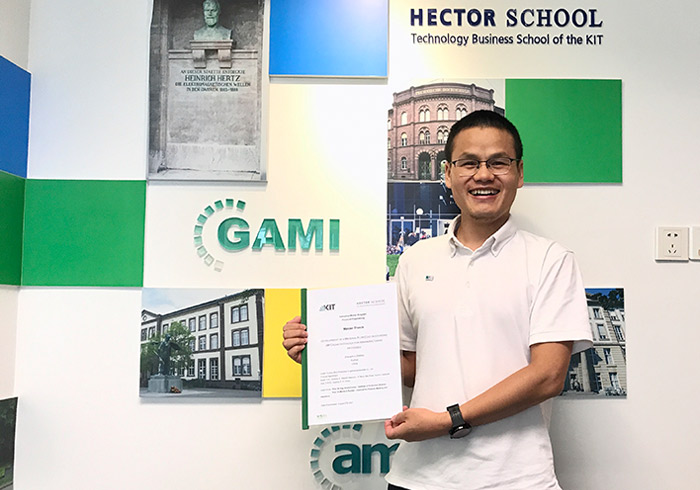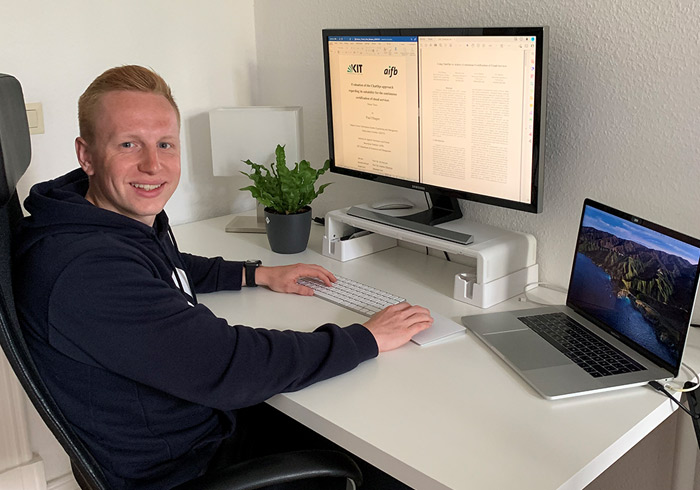Master Thesis Topics
The Master Thesis is the opportunity to distinguish yourself as an expert and, for example, to initiate an innovation project in the company. Also remember to make it known that you have finished your Master's degree - because all the work has to be seen and celebrated!
How Do Ventures Come Up with Their Technology-Driven Innovations? An Investigation of the Ideation Process.
This thesis investigates a pressing issue in today's rapidly evolving technological landscape: the challenge of successfully navigating the early stages of technology-driven innovation, particularly the Technology Application Selection (TAS) process. Despite the recognized potential of technological innovations to spur economic growth, a significant gap persists in transforming these innovations into commercially viable products. This gap is most evident in the fuzzy front end (FFE) stage of development, a critical yet often overlooked phase where the identification of suitable applications for new technologies takes place.
The relevance of this research extends beyond academic interest, offering vital insights for practitioners and policymakers in the field of technology and innovation. By shedding light on the hurdles and requirements in the TAS process, this study contributes to a better understanding of how to harness technological innovations for economic and societal benefits. It also addresses a scientifically neglected topic, bridging a knowledge gap in the pre-development activities of opportunity recognition.
Paul Witzak, Information Systems Engineering and Management, Intake 2021
Vision Based Waste Detection: A Deep Learning Approach and the Potential of Highly Automated Vehicles
Arjan has completed a thesis on the transformation of the OEM market through Highly Automated Driving (HAD). This research delved into the utilization of available data, the application of Machine Learning, and the ensuing economic impact. A deep learning model was developed to detect trash bags in Stuttgart using images Arjan personally captured. The result: todays pretrained models showcase impressive performance. This work hints at exciting developments in the realms of technology and sustainability.
Arjan Kuqi, Mobility Systems Engineering & Management, Intake 2021
Designing a Dashboard for Sustainability Specialists to monitor Greenhouse Gas Emissions in the context of Supply Chain Management
I decided on this topic because I noticed that while there is significant international interest in climate change from a political perspective, there is a lack of sufficient research on an engineering and technical level to practically address the impact of greenhouse gas (GHG) emissions. I believe that research in designing a dashboard for sustainability specialists will fill this gap and provide valuable insights to manage greenhouse gas emissions in the context of supply chain management effectively.
The dashboard can help sustainability specialists in identifying emission hotspots within the supply chain by offering various visualizations such as heatmaps, location maps, and for example an emission flow composition tree. This type of visualization allows sustainability specialists to start with a high-level overview of emissions data, gradually zooming in and filtering to obtain more detailed views at each level, ensuring they can focus on the specific information they need without being overwhelmed by excessive data. Additionally, the dashboard facilitates navigation through different levels of the tree, providing a clear path of the user's exploration and enabling effective identification of emission hotspots.
Find the whole interview of Martin Chau here.
Martin Chau, Information Systems Engineering and Management, Intake 2021
Transparency of data processing within data trustee platform for sleep research
In the current strong momentum of AI, medical researchers are more and more relying on data to understand the disease and find a cure. As central hubs for data, data trustee platforms have been collecting data from donators on the one hand, and responding to the increasing data requirements from researchers on the other hand. However, how did the data trustees process the data, and how researchers consumed the data, all the processes are not transparent to the public. In my thesis I have identified key aspects of the transparency problem and implemented a Blockchain-based solution to help secure donators' data.
Buwei Liao, Information Systems Engineering and Management, Intake 2020
Requirements Analysis for Automated/Autonomous Driving Functions at Overall Vehicle Level
Content:
- Explanation of the potential for safety, comfort, mobility of automated/autonomous driving functions.
- Automated vehicles have to master the Dynamic Driving Task completely and represent complex technical systems -> for the development the requirements have to be defined
- System analysis presents the requirements for the Dynamic Driving Task and system components
- Requirements for automated/autonomous driving functions based on the legal framework in Germany/USA, UNECE Regulations and International Standards
- Application of the results to an exemplary SAE Level 4 automated driving function
Benedikt Neher, Mobility Systems Engineering and Management, Intake 2020
Option Pricing on Noisy Intermediate-Scale Quantum Devices: An Empirical Study on Quantum Amplitude Estimation
Quantitative finance features many computationally expensive problems some of which can be solved more efficiently on quantum computers. The thesis at hand reviews quantum algorithms in the context of option pricing. At first relevant fundamentals of quantum mechanics are introduced. Based on this, quantum computing algorithms for amplitude amplification and phase estimation are discussed. Following Brassard et al. (2002) these two algorithms are then combined to the canonical quantum amplitude estimation (QAE) algorithm. This original QAE allows for a quadratic speedup of classical Monte Carlo methods which makes it interesting for derivatives that have to be priced numerically. The application to option pricing as presented in Stamatopoulos et al. (2020) is outlined. In this way, the thesis contributes to the existing literature by providing the first self-contained introduction to quantum computing methods for option pricing.
As a second contribution this thesis conducts an empirical resource allocation analysis of the QAE algorithm in the context of option pricing. The algorithm is implemented in Python and trade-offs between different resource allocations are examined. In particular, and with regards to noisy intermediate-scale quantum (NISQ) devices, the relevance of the underlying probability distribution approximation and its trade-off with the sampling error are pointed out. Although errors scale as predicted by theory the analysis confirms that current state-of-the-art quantum devices are not yet powerful enough to price options with satisfactory accuracy. Further progress in quantum hardware is required. As a result, a quantum advantage for option pricing is unlikely to become feasible before 2026. Yet, once it can be materialized it can have important implications, for example, in quantitative risk management.
Philipp Kunst, Financial Engineering, Intake 2019
Development of a method for measuring the efficiency of alternative Home energy storage systems
Electrical energy storage systems in combination with renewable energies can make a decisive contribution to the provision of electricity and to achieving the goals of the energy transition. However, they will only be used on a large scale when the electricity they provide is also economical and efficient for the respective end user. There are Battery systems ready to be used in conjunction with photovoltaic (PV) in Germany that can be more economical than pure grid procurement. A significant influence on the storage costs is not only the acquisition costs, but also the quality and performance of the storage system in operation. Therefore, a method to measuring the efficiency of PV Energy Storage Systems is necessary, this will described, among other things, the efficiency of the power electronic components and the battery, furthermore evaluate the standby consumption and the control deviation efficiency. This have been already achieved on Lithium ion batteries, thus, the focus of this subject is on other battery technologies such as Sodium-ion and Sodium nickel chloride. Which are not only environmentally friendly but also completely harmless for the end user.
Luis J. Romero Arias, Energy Engineering and Management, Intake 2019
Experimental process investigation for the optimisation of Roll2Roll slitting of electrodes for Lithium-ion battery cell production
There are a number of intricate production procedures involved in the manufacturing process chain for contemporary Li-ion battery cells. The effectiveness and quality of these components have a sizeable bearing not only on the pricing of the battery cells, but also on their safety and their overall performance. The slitting of the calendared electrode foils using a Roll2Roll machine is one of the procedures involved in this process. In this situation, high process speeds are required for a solution that is both inexpensive and effective, and these speeds must be maintained while maintaining the highest quality criteria for the electrode cutting edges that are produced. The manufacturing sector and scientific research have already uncovered and categorized a number of common defect patterns. These include the production of burrs on the aluminum and copper foils, which constitute a huge safety risk for the thin and delicate separators and can lead to short circuits. Burrs can also be caused by abrasions and scratches. In addition, the waviness that is produced in the cutting-edge areas makes further processing more difficult in steps that are further downstream in the process, such as the single sheet stacking. The work done within the scope of this master thesis includes the research on the current state of science and technology in the mechanical slitting of electrode foils. The formulation and execution of a strategy for conducting experimental tests in order to ascertain the extent to which certain process parameters are related to the quality of the cutting edge. Integration of sensors into the slitting machine that is currently at hand for the purpose of monitoring the slitting process. Integration of a residue particles collector and performance of primary particle characterization of the leftover particles which is valuable information for the companies who develop the blower and residue collector systems. Evaluation of the findings in order to formulate suggestions for improving the effectiveness of the process's parameter windows.
Tejas Vinay Kulkarni, Energy Engineering and Management, Intake 2019
The Future Contribution of Controlled Charging and Vehicle-to-Grid in Securing the Swiss Electrical Supply
In face of the impending restrictions in electricity trading, the rise in electricity demand and the decrease of the installed capacity of conventional power plants, securing a reliable electrical supply will pose increased challenges for Switzerland. Growing public awareness of the realities of climate change and the necessity of reducing greenhouse gas emissions is driving a sharp increase in plug-in electric vehicle (PEV) sales in Switzerland. In the context of this thesis, the contribution of PEV to secure the Swiss electrical supply by smoothing the residual load with controlled charging and vehicle-to-grid (V2G) was investigated. A hybrid modelling approach was employed, combining a top-down macro-econometric Bass model with a bottom-up micro-econometric binary logit model. The charging behaviour was simulated by applying the hybrid model on representative mobility data for Switzerland. The potential to smooth the residual load was finally investigated with a non-linear mixed integer optimization model. The results show that residual load fluctuations can be minimized significantly and the highest peaks in the winter can be reduced by approximately 5 % in 2025 and 11 % in 2030 with a 20 % share of bidirectional PEV within the electric vehicle fleet. With a lower share of bidirectional vehicles, the reduction potential decreases accordingly.
Elia Limarzo, Mobility Systems Engineering and Management, Intake 2020
Drivers and Inhibitors for Healthcare Organizations to Adopt Federated and Swarm Learning
This thesis closes the gap in scholarly knowledge on adoption drivers and inhibitors for Federated Learning and Swarm Learning in healthcare, which promise the preservation of privacy while complying with legal regulations. Thus, it serves as an enabler for future research as well as for solution providers and healthcare organizations to address adoption drivers and combat inhibiting factors. Ultimately, it helps accelereate the adoption of FL/SL in healthcare, which will enable new forms of collaboration, AI-driven medical advances, and innovation.
Johann Kortsch, Information Systems Engineering and Management, Intake 2020
Automatic assessment of pragmatic quality aspects of executable BPMN models
In literature, various approaches exist to assess the quality of business process models. However, these approaches mostly refer to strategic process models and do not take into account that companies nowadays also use their process models for automation by use of workflow engines. Due to the new scope of use of process models, there are also new requirements for the quality of the process model. In addition, the process model is now part of a software and therefore subject to software development requirements. In this master thesis, pragmatic quality criteria of executable BPMN process models are identified and subsequently, a concept is developed on how these criteria can be assessed. For this purpose, existing evaluation methods are presented and their limitations in terms of executable models are shown. To automate the assessment of the criteria and to integrate it into the software development of process applications, a prototype was developed that can evaluate the pragmatic quality of BPMN models.
Manuel Dittmar, Information Systems Engineering and Management, Intake 2020
Development of a forecast model for the spatial distribution of lion traction batteries in Germany
The purpose of this thesis is to forecast and examine the Electrical Vehicle distribution within the different 16 states in Germany. This research shows how this forecast is crucial, especially that Electrical Vehicles will play a lead role in a more sustainable and environmentally friendly mobility, that is of course assuming that the electricity is provided from renewable sources. In Germany, Electrical Vehicle numbers have dramatically increased, thanks to the attractive government subsidies and financial incentives, the technological advancements in charging infrastructures and battery technology, the increasing individual concerns regarding climate change and more efforts done to encourage the utilization of electrical mobility. For orderly accommodations for this rapid development, it is of utmost importance to get an accurate predication of the Electrical Vehicles that would be on the road in several areas in Germany, as this data would be essential for a timely plan for the electromobility infrastructure, such as the charging stations infrastructure, the expected load on the electricity grid, the impact it would have on the renewable energies requirements and, not to mention, the influence it will have on the manufacturing companies as well. Therefore, this research utilizes the Bass Diffusion model, which is one of the most accredited models to forecast the diffusion of the innovative technologies and products within a social system. This model mathematically predicts the future adoptions using previous sales data, through two combined attributes: Innovators, who adopt the innovation immediately after release, and Imitators, who adopt the innovation based on the word-of-mouth communications with existing adopters. An analytical evaluation of the main model's parameters is carried out, to reveal the interesting simulations findings, which opens the door for more extensive research opportunities in this field.
Jasmin Hariri, Energy Engineering and Managment, Intake 2019
Exploring and Evaluating Sound Design for Percussive Instruments with Deep Variational Autoencoders
Exploration of different Generative Deep Learning Architectures that can be used in the Sound Design process for percussive Instruments. Moreover the development and evaluation of a prototype that showcases the possibilities and advantages of Variational Autoencoders for Sound Engineers.
Emrehan Firtin, Information Systems Engineering and Management/Digital Services, Intake 2019
Data - Driven Automation of API Lifecycle Management for Embedded Systems in the Automotive Industry
The increased digitalization of the vehicle and the upcoming prospect of fully autonomous vehicles give increasing importance to the in-vehicle infotainment system. Furthermore, with new players originating from the consumer electronics industry entering the market, customers expect an increase in feature scope and frequent updates.
The existing development methodologies and software architectures need to be adapted to satisfy the changing consumer demand. Instead of having few monolithic components, the trend is to have many smaller software modules focused on a specific feature and developed independently. The development of these modules can then be distributed across different teams in the company or even opened up to external developers. However, dividing the software does not resolve functional dependencies. Therefore this paradigm shift creates new interfaces between the different modules for cross-functional features.
Compared to a service-oriented architecture, the governance process for the interfaces between the different modules needs to be more flexible. In addition, the interfaces need to be on a higher abstraction level and be easy to consume to accommodate to the new business requirements. At the same time, it is still important to manage the interfaces to ensure consistency and stability.
This thesis covers the lifecycle aspect of interface management. It compares different methodologies from service-oriented architecture to consumer-focused web development methods. Based on this analysis, it proposes a process for managing the lifecycles of embedded application programming interfaces. A concept for an automated and data-driven tool to support and safeguard this process is described. This approach combines data from service providers and service consumers. It can enforce the lifecycle process and support developers by giving insights into the available and used application programming interfaces.
The concept is implemented for the QML language used by the Qt framework. This implementation is successfully applied to a user interface software project in the automotive infotainment field.
Leo Benz, Mobility Systems Engineering and Management, Intake 2019
Development of a material flow cost accounting methodology for remanufacturing processes
The thesis aims to increase the acceptance of remanufacturing industry with a visualization performance of cost results, remanufacturing infrastructure investment appraisal and carbon emission. The modified material flow cost accounting model is based on the digitalization methodology for sustainable further development in industry 4.0 environment.
Zhengchun Zhang, Financial Engineering, Intake 2018
Static Performance Estimation for Embedded Processors based on Compiler Intermediate Representations
The end of single-core processors has come! New processors are increasingly characterized by heterogeneous multi-core processors. This is because only heterogeneous multicore processors can efficiently use the ever-increasing number of transistors to increase performance. However, multicore processors shift the problem of parallelization from hardware to software. As a result, the programmer is responsible for parallelizing the application and has to deal with parallelization issues. Therefore, we at emmtrix are researching automatic parallelization of C code for heterogeneous multicore processors. For automatic parallelization a performance estimation of the sequential input application is important. The previous performance estimation is only based on C code and therefore does not consider the influence of compiler optimizations. With this thesis, a new performance estimation is developed using LLVM compiler intermediate representation (IR).
Pranjal Ranka, Information Systems Engineering and Management, Intake 2019, working as R&D SW Developer at Bruker Ettlingen.
Using ChatOps to Achieve Continuous Certification of Cloud Services
Continuous service certification (CSC) recently emerged as a promising means to provide ongoing assurances and disrupt pertinent certification approaches. CSC involves the consistent gathering and assessing of certification-relevant data by certification authorities about service operation to validate ongoing adherence to certification criteria. While research on CSC is increasing, practitioners still struggle in transferring researchers' suggestions and guidelines into practice. This study provides a tentative design and a prototype of a monitoring-based service certification (MSC) system based on the novel ChatOps approach. Iterative evaluations support our propositions that ChatOps' three key elements, a chat platform, chatbots, and third-party integrations, support the achievement of CSC. We contribute to research and practice by proving the technical feasibility of an MSC system, guiding future research and practitioners on achieving monitoring-based CSC, and validate the applicability and usefulness of extant guidelines on monitoring-based CSC proposed by prior research.
Paul Ohagen, Information Systems Engineering and Management, Intake 2019
other Authors: Sebastian Lins, Scott Thiebes, Ali Sunyaev










